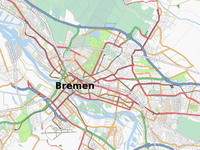User:Skybunny/Key:place
 |
| Description |
|---|
| The place tag is used on a single node to mark the centre of a named settlement as well as on the whole area to mark its extent. |
| Group: places |
| Used on these elements |
| Documented values: 31 |
| Requires |
|
| Useful combination |
|
(On nodes)
|
| See also |
| Status: de facto |
| Tools for this tag |
|
- Main article: Places
The place key is used to indicate that a particular location is known by a particular name, and to indicate what sort of "place" it is. Place keys exist on single nodes by themselves, to show the center of a "place" and as an aid for rendering a label or as a navigation waypoint. They also can exist on a relation, to additionally show the extent of an area.
A place tag should exist on an OSM object for every significant human settlement (city, town, suburb, etc.) and also for notable unpopulated, named places.
Usage
Nodes
The simplest way to tag a place is to position a node ![]() at the recognized centre of a place, which may be the location of the town hall, central square, or similar for a populated place.
at the recognized centre of a place, which may be the location of the town hall, central square, or similar for a populated place.
Relations
| Mapping populated places as extents is often not verifiable. More detailed discussion of this can be found in Talk:Key:place#Verifiability_of_mapping_populated_places_as_areas. |
You may further define a place by also defining a boundary for it. The best way to do this is by creating a place relation.
If you choose to map a place with a relation, and a previously existing node ![]() for the
for the place=* exists, keep tags for the place on that node, and assign it the waypoint relation, to ensure no information about the place=* is lost, and that that information is easily accessible to machine interpreters.
Areas
An encouraged usage until recently was to apply the place=* tag to areas. The problem is that OSM Areas, by themselves, cannot have associated nodes. Historical experience has shown that relation member nodes are extremely useful (especially for machine data consumers) to help interpret and render place "areas" created in OSM, whether to provide additional information, or for backwards compatibility.
See the place relation for best practices for creating boundary relation shapes.
Additional tags
If you have a way of knowing the population of a place (from a free data source), the population=* tag typically is added to the place. Also useful is the addition of wikidata=*/wikipedia=*. For a standalone node, these tags belong on the node the place tag appears on. In a place relation, this belongs on the node with role waypoint.
Values
See below for the main tag values
Administratively declared places
This table is a wiki template with a default description in English. Editable here.
Populated settlements, urban
This table is a wiki template with a default description in English. Editable here.
Populated settlements, urban and rural
This table is a wiki template with a default description in English. Editable here.
Other places
This table is a wiki template with a default description in English. Editable here.
Additional attributes
This table is a wiki template with a default description in English. Editable here.
Category:Keys:Address Category:TagsSupportedBy:Traveling_Salesman
See also
border_type=*place:ph=*- a Philippines-specific tag used on places unique in the Philippines. It is still proposed, but already used.